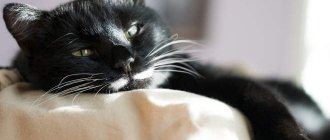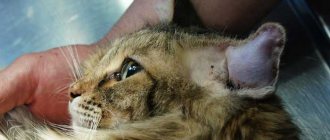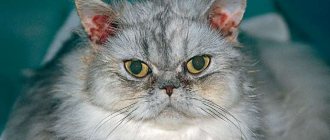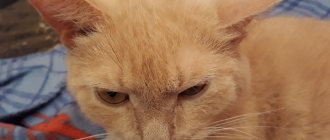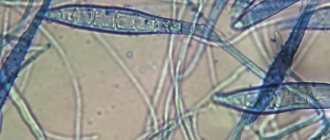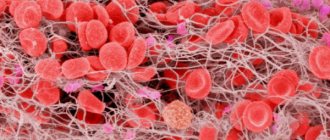Unlike dogs, a rare pathological process that occurs in domestic cats is hemorrhoids. This is a disease that develops as a result of varicose veins located in the rectum and anus.
Many cat owners are surprised to learn that their pet has hemorrhoids, as they consider the disease to be originally human. In veterinary medicine, any type of pathological process in the anal area, accompanied by inflammation, is considered hemorrhoids.
The manifestation of hemorrhoids resembles a red tumor that appears at the location of the anus. Cat owners should closely monitor the health of their pet and at the first characteristic symptoms, contact a veterinarian for help. This is due to the fact that the development of hemorrhoids has a similar clinical picture to other pathological conditions in the anal area - inflammation of the paraanal glands and rectal prolapse.
Despite the commonality of the disease, it poses a serious danger to the life of the animal. Without the necessary treatment, the pet may die. It is important to know what can trigger the development of hemorrhoids, what clinical signs are typical for it, what treatment methods exist and how pathology can be avoided.
Causes of hemorrhoids in cats
What leads to hemorrhoids in a cat
Walking on two legs, upright, is one of the characteristics of a person, which not only distinguishes him from animals, but also has a number of negative aspects. A person’s center of gravity is shifted, which leads to diseases of the spine and poor circulation in the pelvic area, which leads to hemorrhoids in cats. In cats, the center of gravity is fine, but problems with the intestines and blood vessels arise for a number of other reasons. The most common ones are the following:
- improper and inadequate nutrition. Leads to a number of diseases, including hemorrhoids. Most often, those cats that get sick are those that are fed only cheap dry food from the store;
- digestive disorders. A direct consequence of poor nutrition, which leads to constant constipation and disorders;
- overweight. A frequent companion of apartment cats, it can also appear after the cat has been castrated;
- lack of physical activity;
- diabetes and a number of other diseases that lead to the walls of blood vessels and veins losing their elasticity and firmness;
- hormonal disorders;
- helminths, in simple terms, worms.
All these factors lead to the fact that the veins lose their tone, and blood stagnation begins in them, nodules form. Moreover, these nodules can be either inside or fall out through the anus.
Risk group
Snot in a kitten, cat and cat: how to treat it
A variety of felines are susceptible to the disease. Pets at risk include:
- Spayed or neutered. In this case, the disease may develop due to changes in the animal’s hormonal levels.
- Breeds prone to obesity. These include: British, Scottish Fold, and so on. For them, it is necessary to select special food and carefully monitor the animal’s weight.
- Cats eating low-quality foods, such as dry food such as Whiskas or a cheaper category.
- Having a genetic tendency passed on from their parents.
Obesity can cause hemorrhoids in cats
Main symptoms of hemorrhoids in cats
Symptoms and manifestations of hemorrhoids in cats
Symptoms of pathology in cats are very similar to those observed in humans. Although the animal cannot complain to its owner, the changes in its behavior speak for themselves. So, the cat’s gait changes noticeably, becoming sweeping compared to what it was before. When going to the toilet, the animal experiences pain and will meow pitifully. The stool itself becomes dry and clots of mucus and possibly blood will be visible in it. Upon visual examination, inflammation of the anus will be noticeable, and if you palpate around it, you will clearly feel compactions - hemorrhoidal nodules. You should not make a diagnosis or begin treatment yourself unless you are a veterinarian. This is due to the fact that there are a number of diseases that are very similar in their manifestations to hemorrhoids, but are not hemorrhoids. Incorrect treatment can harm the animal and even lead to its death.
Let's sum it up
Cats of any age do not tolerate hemorrhoids well. The fact is that this illness is extremely painful for them, especially if there are any concomitant illnesses. At the same time, unfortunately, changes in the behavior of our pets cannot always be associated with illness. So, for example, if you just adopted a new pet, your cat's quirks may seem like just jealousy. In order not to waste precious time, try to carefully study all the symptoms we listed in the text.
If hemorrhoids are not treated in time, they can transform into other ailments, such as cancer, so you should not put off visiting a veterinarian
In addition, it would be a good idea to remove your cat from the risk group for this disease even before hemorrhoids appear. So, if you have an obese animal, start playing with him today, change the water in the bowl of the cat who drinks little (maybe you just rarely do this), change his diet and add more liquid. And remember: your pet’s health depends only on your efforts.
What can be confused with hemorrhoids in cats?
Inflammation of the anal glands
What diseases are hemorrhoids confused with in cats?
In cats, in the rectum near the sphincter there are two anal glands that produce a secretion that is not only the source of the animal’s individual smell, but also a powerful antiseptic. In addition, they secrete a “lubricant” that facilitates the passage of feces. It is the inflammation of these glands that is most often mistaken for hemorrhoids. Meanwhile, an attempt at improper treatment will lead to the formation of fistulas and a severe inflammatory process.
Itching in the anus
The cat begins to “ride” along the floor with its hind end, the hair falls out around the sphincter, inflammation and swelling appear. A very common occurrence with worms.
Rectal prolapse
Rectal prolapse occurs in cats as a consequence of long-term digestive disorders, as well as with senile changes, when tissues and muscles lose their firmness and elasticity. Bowel prolapse is very similar to, but is not, the later stages of hemorrhoids.
Description
Hemorrhoids look like a red tumor in the anus. Hemorrhoids rarely appear in cats due to their body structure and the inability to walk on their hind legs. The disease appears due to blockage of the veins. Despite the identity of the pathology with humans, its treatment in pets is different.
Incorrect therapy will provoke the development of inflammation. Hemorrhoids appear against the background of deformation of the veins. The nodes gradually grow, painful sensations and bleeding appear. Disruption of the anal glands provokes a decrease in secretion, which is an antiseptic and protects the pet from inflammation.
Hemorrhoids develop in three stages. On the first, the knot looks like a small dense ball. It is not yet visible visually; it does not protrude from the anus. At the second stage, the node comes out. Visually, the ball is pale pink, cone-shaped. At the third stage, the node grows and begins to be injured during emptying. A bleeding ulcer appears, gradually developing into an open wound. This can cause infection to enter.
How to treat hemorrhoids in a cat
How to cure hemorrhoids in a cat
If the pathology is detected at an early stage, then the treatment will be quite “gentle”; the main thing in it will be to normalize the animal’s nutrition so that its gastrointestinal tract works “like a clock.” You will have to forget about dry food from the store. The diet should be as balanced as possible, with all vitamins, minerals and trace elements. Pay special attention to fiber, it is responsible for the normal formation of feces and bowel movements. Wash your cat's anus several times a day with warm water, without using soap or other products. After the procedure, lubricate the anus with a small amount of Levomekol, Vaseline or sea buckthorn oil. If hemorrhoids are already severe, then suppositories will be necessary in the anus, which will relieve inflammation and pain. If a cat’s hemorrhoids have reached an advanced stage, then it is too late to carry out drug treatment—surgery is necessary. It is performed in a veterinary clinic. There are two main methods: excision of hemorrhoidal cones under general anesthesia or freezing them with liquid nitrogen under local.
Diet and care
The main goals of a therapeutic diet are to return the natural consistency of stool and reduce the load on the inflamed intestines. New nutrition involves:
- Switch to easily digestible foods. All dishes are boiled or steamed, since the lack of heat treatment complicates the digestion process. You can cook rice, oatmeal or buckwheat porridge using the broth left after cooking meat.
- Chop food thoroughly before serving. Too large an unchewed piece can injure the mucous membrane.
- Enriching the diet with fiber and vitamins. Use special probiotics, vitamin complexes or bran soaked in kefir. Remember that all fermented milk products must have minimal fat content and an expiration date.
- Switching to veterinary food. The lack of water is compensated for with wet canned food from the same line, intended for the treatment of gastrointestinal pathologies.
In addition to changing your diet, it is important to reconsider your existing load. Fluffy couch potatoes are encouraged to play actively, and pets that are too restless are temporarily restricted in their movements.
Before recovery, you need to take care of hygiene. Clean the anus and perineum twice daily with warm water or alcohol-free wipes. After washing, be sure to lubricate the anus with antiseptic ointment or Vaseline oil. This will prevent infection from entering the wound and speed up its healing.
How to Avoid Hemorrhoids in Cats
How to prevent hemorrhoids from appearing in a cat
There are several simple but effective tips that will minimize the likelihood of hemorrhoids in your pet:
- Twice a year it is necessary to give the cat anti-worm medications;
- Carefully control your diet. If the animal begins to gain excess weight, then correct it;
- If indigestion lasts more than 2-3 days, contact your veterinarian rather than relying on it to go away on its own.
Hemorrhoids are not observed in cats living in villages or private houses in the city. The explanation for this is very simple. Researchers attached sensors to the cats and looked at the route they cover every day while walking - it turned out to be tens of kilometers. This is a very large and necessary physical activity, which domestic cats are deprived of. Make a “bow” by tying a piece of notebook paper folded into an accordion to a string and play with your pet for 10-15 minutes a day. This will strengthen his muscles and overall health.
Diagnosis of the disease
Hemorrhoids in a cat and how to treat it depend on what caused it, since such an ailment is very unusual for representatives of the cat family. Blood clotting will need to be checked. For this purpose, a coagulogram is performed.
In addition, doctors recommend testing animals for hormones and determining blood sugar levels. It is also necessary to check the stool for the presence of parasites and their eggs. In addition, the veterinarian examines the anus and evaluates the general condition of the anal glands.
Prevention
Treatment of hemorrhoids is not the most difficult process, however, preventing the development of the disease is still easier. Recommendations that can help your cat avoid developing the disease:
- carrying out preventive deworming every six months;
- monitoring the correct diet of the cat and the amount of fluid consumed;
- inclusion of vitamins, minerals and fatty acid complexes in the diet;
- periodically clean the anal area with wipes;
- monitoring the pet’s weight and increasing physical activity, as well as providing a diet for signs of obesity;
- In case of prolonged constipation or diarrhea, you should immediately consult a doctor.
If you follow these tips, the risk of hemorrhoids is almost zero.
